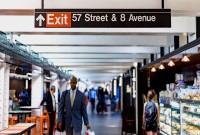- Home
- Business Processes
- Industry Knowledge
- Aerospace Industry
- Automotive Industry
- Banking Domain
- BFSI Industry
- Consumer/ FMCG Industry
- Chemicals Industry
- Engineering & Construction
- Energy Industry
- Education Domain
- Finance Domain
- Hospitality Domain
- Healthcare Industry
- Insurance Domain
- Retail Industry
- Travel and Tourism Domain
- Telecom Industry
- Leadership Skills
- eLearning
- Home
- Domain Knowledge
- Retail Industry
- Retail Industry - Business Model
Retail Industry - Business Model
A retail business model articulates how a retailer creates value for its customers and appropriates value from the markets. In retail, a business model would dictate the product and/or services offered by the retailer, the pricing policy that he adopts. Many different types of retail establishments exist, and, the overall industry has seen a significant blurring of the boundaries that separated the wide range of retail businesses. Understand the key business models adopted by the retail industry. Understand the distinctive ways that retail industry players use to reach to the end consumer.
A retail business like any other type of business can be owned by different types of entities. It could be a sole proprietor, partnership concern, corporation, a cooperative body, a joint venture, or other types of legally permitted formats. A majority of retail businesses in India are sole proprietorships and partnerships due to their nature. Every business has its distinctive way of organizing the very many activities that are involved in delivering its product or service to the end consumer. In retail parlance, one would term it as the format adopted by the retailer to reach his end consumer.
Retail enterprises can be either independently owned or operated or part of a chain. Chains may all be owned by a single company, and the individual stores may be franchises that are independently owned by a small business person. Many different types of retail establishments exist, and, as noted above, the overall industry has seen a significant blurring of the boundaries that had long separated the wide range of companies operating under the retail umbrella.
Seven Key Business Models in Retail
A retail business model articulates how a retailer creates value for its customers and appropriates value from the markets. Given below are the main types of business models that exist in the retail industry:
1. Independent Retailer:
Independent retailers are the entrepreneurs who have built their business from the ground up. They can take help from various agencies in the process like consultants, builders, or other contractors, but the decision-making authority always rests with the independent retailer, who is also the owner of the retail enterprise. Independent Retailer generally operates one outlet and offers personalized service, at a convenient location and establishes close customer contact.
Roughly 90% of all the retail businesses are managed and run by independents, including barbershops, dry cleaners, furniture stores, bookshops, Gas Agencies, and neighborhood stores. This is due to the fact that entry into retailing is easy and it requires low investment and little technical knowledge. This obviously results in a high degree of competition. Many independent retailers fail because of the ease of entry, poor management skills, and inadequate resources.
2. Existing Retail Business:
This categorization includes those retailers who have taken over an existing business by investing in it. They gain ownership of an existing business and use that foundation to build upon it. The primary benefits are the goodwill and reputation that comes with the enterprise. This brings down the entry-level risks as the business has already been established by the previous owner.
3. Retail Chain:
This business model involves common ownership of multiple units where the purchasing and decision making is centralized. It can be defined as ’’ a group of two or more stores whose activities are determined and coordinated by a single management group”. Stores that are part of a Chain often rely on, specialization, standardization, and elaborate control systems. Retail chains are able to serve a large dispersed target market and maintain a brand name for their chain. Chain stores have the opportunity to take advantage of "economies of scale" in buying and selling goods. They can maintain their prices, thus increasing their margins, or they can cut prices and attract greater sales volume. Examples of retail chains in India are Shoppers stop; Westside and IOC, convenience stores at select petrol filling stations.
4. Retail Franchising:
A franchise is a store with the right to use a certain business name, product, and business model. Franchising is the practice of using another firm's successful business model. The word 'franchise' is of Anglo-French derivation - from franc - meaning free, and is used both as a noun and as a (transitive) verb. For the franchisor, the franchise is an alternative to building 'chain stores' to distribute goods that avoids the investments and liability of a chain. The franchisor's success depends on the success of the franchisees. The franchisee is said to have a greater incentive than a direct employee because he or she has a direct stake in the business.
The franchisee receives marketing, support, and training from the franchisor in order to make the lay the foundation, use the trusted business strategies, and drive economies of scale in buying and selling. It is a contractual arrangement between a "franchiser" and a "franchisee" which allows the latter to conduct a certain form of business under an established name and according to a specific set of rules.
The franchise agreement gives the franchiser much discretion in controlling the operations of small retailers, in exchange for fees, royalties, and a share of the profits, the franchiser offers assistance and very often supplies as well. Classic examples of franchising are McDonald's, Subway, PizzaHut, and Nirulas.
5. Retail Cooperatives:
A retail cooperative is a group of independent retailers that have combined their financial resources and their expertise in order to effectively control their wholesaling needs. They share purchases, storage, shopping facilities, advertising planning, and other functions. The individual retailers retain their independence but agree on broad common policies. “Amul” is a typical example of a cooperative in India.
6. Retail Dealership:
The dealership is a cross between a franchise and an independent retailer. A dealership is an authorized seller that has the right to sell a particular brand of products and usually doesn't have to pay any fees to the licensor. When setting up a dealership, the dealer generally doesn't receive any support.
7. Network Marketing:
This is a unique business model that involves not only selling a product but also recruiting other salespeople to sell the same product. In this way, sales of the product depend entirely on the people in the network. Multi-level marketing (MLM) is a marketing strategy in which the sales force is compensated not only for sales they personally generate but also for the sales of the other salespeople that they recruit. This recruited sales force is referred to as the participant's "downline", and can provide multiple levels of compensation. Other terms used for MLM include pyramid selling, network marketing, and referral marketing. Most commonly, the salespeople are expected to sell products directly to consumers by means of relationship referrals and word of mouth marketing.
Related Links
You May Also Like
-
FMCG or consumer packaged goods (CPG) are products that are sold quickly and at relatively low cost, examples include non-durable goods such as soft drinks, toiletries, and grocery items. They generally sell in large quantities, so the cumulative profit on such products can be substantial and these industries often operate on thin margins.
-
Durable goods are consumer goods that have a long life span (e.g. 3+ years) and are used over time. Highly durable goods such as refrigerators, cars, or mobile phones usually continue to be useful for three or more years of use, and hence durable goods are typically characterized by long periods between successive purchases.
-
Retail Industry: Revenue Model
Understand the traditional retail revenue model and, what are the variations in different revenue models adopted by key players in the retail industry. Analyze the pros and cons of various models. The most common and most profitable revenue model is that of the traditional retailer. The traditional retailer profits by selling products and services directly to buyers at a mark-up from the actual cost.
-
Markets are continuously changing and to understand the dynamics of any industry it is important to understand what is happening and how the industry market players see the future for the industry. In this article, we will discuss the recent trends witnessed by the retail sector. This document provides insights into major trends identified for the retail sector.
-
All of us are consumers, from cradle to grave, to be more precise, from the womb to grave or cremation. In a sense, the history of the consumer is the history of mankind. Consumers are the largest economic group in any country. They are the central point of all of our economic activities. But the very same consumers ate the most voiceless group also. The nature of consumer in terms of needs, consumption patterns, and problems has been changing and evolving along with the social and economic development in the course of history.
-
The retail value chain defines a series of actions that enable businesses to sell their products to customers. Value Chain for any industry describes how an industry is structured and its methods for maximizing revenues. Learn the value chain of the industry. Learn about the key partners, key activities, cost structures, and revenue streams of the retail sector. The value/supply chain analysis reveals the business activities which comprise the movement of retail goods.
-
Retail Industry: Current Challenges
Today consumers are choosing multichannel buying experiences and expect that to be a seamless experience. To attract customer loyalty, retailers need to provide an experience that stands out from others. Learn the challenges faced by the retail sector today. Multi-channel sale avenues, changing consumer behavior, technological advances, rising competition, rising frauds, and supply chain management are some of them that require immediate attention.
-
Challenges in Consumer Goods Industry
There are tens of thousands of general consumer products manufacturers in the United States. They compete to develop the best products at the most affordable price for the greatest number of consumers. Challenges for these organizations include meeting the changing demands of customers, maneuvering through a consolidating market, and executing strategies to grow profitably.
-
Retail Industry: Key Performance Metrics
You cannot manage what you do not measure and cannot measure what you do not define. Learn the key performance metrics for the retail industry like Sales per square foot, Gross margins return on investment, Average transaction value, Customer retention, Conversion rate, Foot traffic, and digital traffic and Inventory turnover, etc. These metrics are used across the globe by key industry players to track and improve their performance.
-
Retail Industry – Drivers & Dynamics
To succeed in the retail sector, retailers must offer compelling value propositions and be responsive to market dynamics. The continued rise of e-commerce has altered the dynamics of the retail industry in such a way that has forced retailers to drastically reallocate their resources to multi-channel strategies. This article focuses on retail industry drivers and dynamics that provide the reader with a basic understanding of the factors that influence this trade. Understand the business drivers and dynamics of retail industry
Explore Our Free Training Articles or
Sign Up to Start With Our eLearning Courses

About Us
Learning
© 2023 TechnoFunc, All Rights Reserved









